Hydrodynamic interactions in DNA thermophoresis†
Abstract
We theoretically study the molecular-weight dependence of DNA thermophoresis, which arises from mutual advection of the n repeat units of the molecular chain. As a main result we find that the dominant driving forces, i.e., the thermally induced permittivity gradient and the electrolyte Seebeck effect, result in characteristic hydrodynamic screening. In comparison with recent experimental data on single-stranded DNA (2 ≤ n ≤ 80), our theory provides a good description for the increase of the drift velocity up to n = 30; the slowing-down of longer molecules is well accounted for by a simple model for counterion condensation. It turns out that thermophoresis may change sign as a function of n: for an appropriate choice of the salt-specific Seebeck coefficient, short molecules move to the cold and long ones to the hot; this could be used for separating DNA by molecular weight.



 Please wait while we load your content...
Please wait while we load your content...